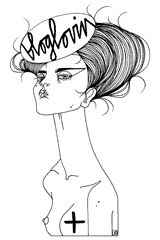"It is not just a book about animals, it is much more; it is the story told in simple language, of how animals live, and how they have evolved to suit their way of life. It is, in fact, a book about the evolution of mammals."
On the front inside cover of the book is this great picture of animal skeletons.
The book begins; " Everything can be divided into 'animal, vegetable or mineral', as in the game. The animal we mean is any creature which can move of it's own free will, including birds, fishes, reptiles and insects. When we speak of animals in the ordinary way we really mean mammals, which are all the animals which produce their young complete, and nourish them in infancy on their mothers' milk, This book is about those animals, the mammals."The book then goes through the biology of mammals and through page titles like; Hooves and Paws, Claws and Teeth , Tusks and Horns, Eyes, Ears, Noses, Voices and Tails; explaining the process of evolution by natural selection.
There are the usual wonderful illustrations displaying the magnificent diversity of the animal kingdom.
The book ends with the typical human preoccupation of our own similarity, yet difference, to the rest of the animal kingdom. Having explained what instinct and knowledge are and that animals operate mostly on instinct the author does recognise that some young animals are taught by their parents as children are; "A mother bear teaches her cubs to stay with her, to remain quiet and to hunt, and if they are disobedient she picks them up and spanks them - hard."
However, "The top order of the mammals is called the primates, and includes monkeys apes and Man. These have the most highly developed hands which they use in varying degrees under the direction of the brain... Intelligence depends on using the brain to think and reason, instead of relying only on natural instincts."It's quite interesting that intelligence is being defined like this, as the co-ordination of brain and hand. I think more modern books would probably place more emphasis on the brain and the animals ability to communicate.
In my collection of Ladybird books from childhood I have more of their Natural History series than any of their other non-fiction series. The last Ladybird Tuesday I joined in with was a post on one of the other books in this series, Plants and How They Grow, and I think next week I will post on Birds and How They Live.
This post is part of the Ladybird Tuesday linky started on the Being Mrs C blog, take a look at her posts here.
The rest of Mrs Fox's Ladybird Tuesday posts are here and if you have a collection of Ladybird books, please do feel free to join in.


























No comments